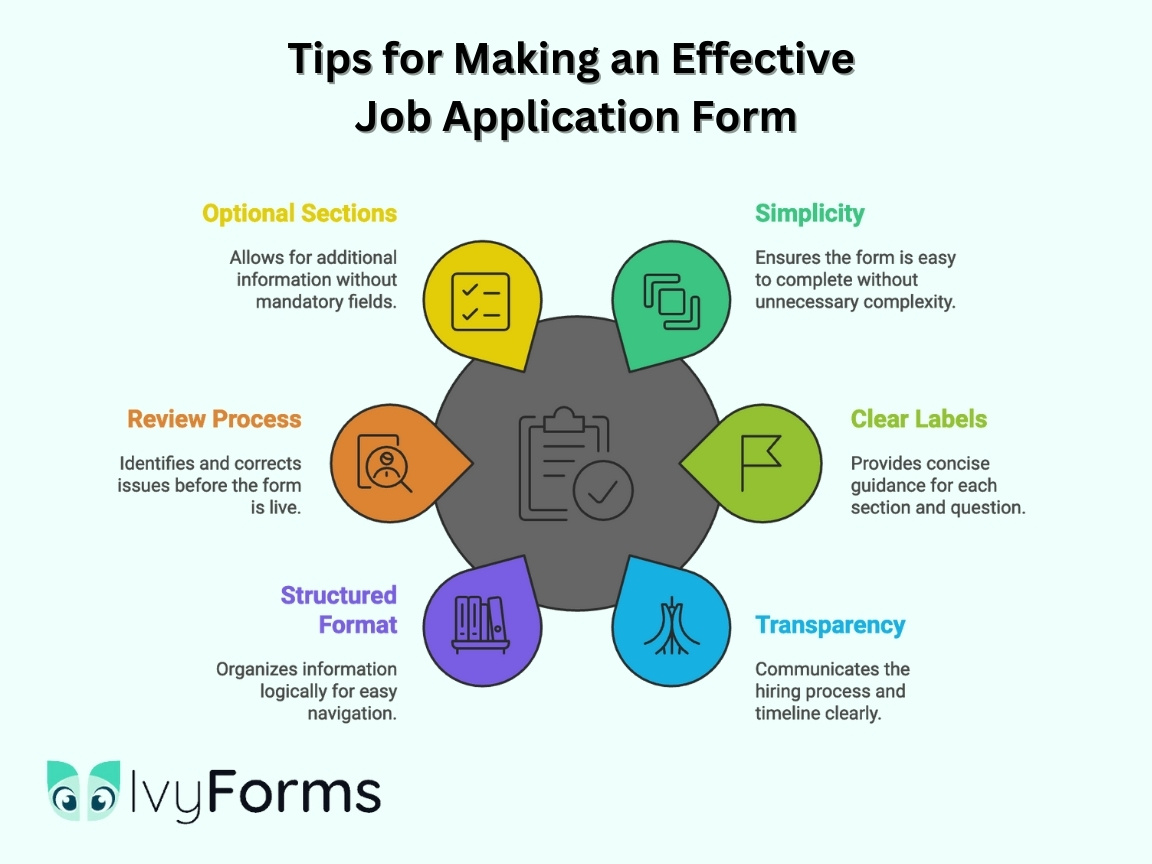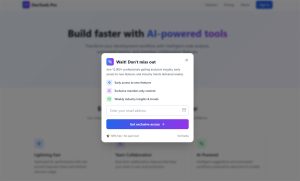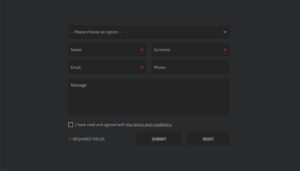Most visitors leave your website without taking action. Industry data puts this number around 96-97%. Exit-intent forms capture a portion of that departing traffic by displaying targeted messages at the…
Table of Contents
The competitive job market is a tough nut to crack, and as an employer, finding the right talent can feel like an uphill battle. A well-designed job application form is essential in this process, serving as the first point of contact between you and the candidates.
But how to make a job application form that serves this purpose while maintaining a positive experience for an applicant? The key is to find the right balance between gathering the right amount of information without creating an overwhelming atmosphere.
If you are feeling kind of lost in the process, don’t worry. Creating an effective job application form doesn’t have to be complicated. In this guide, we’ll break down the essential elements of a successful job application form and include the best practices to follow.
Why Do Job Application Forms Matter?
Job application forms play a major part in the hiring process for several reasons. First and foremost, they provide a standardized way to collect essential information from all candidates, making it easier to compare qualifications, experiences, and other important skills. Having this uniformity helps streamline the review process and ensures no important data is overlooked.
A well-designed application form demonstrates professionalism and shows that you value candidates’ time and effort. Additionally, a positive application experience can set the tone for the rest of the interactions, fostering goodwill and encouraging top talent to apply. In fact, candidates are 38% more likely to accept the job if they are satisfied with the application process.
Ultimately, a job application form not only helps you find the right talent but also assists you in communicating the company’s values and commitment.
How to Create a Job Application Form: Key Elements to Include
Nearly 50% of potential candidates would consider applying for a job instantly if the process appeared simple. Therefore, focusing on key elements of a job application form can help you secure an abundance of applications while ensuring you collect all the necessary data.

Basic personal information
First and foremost, at the beginning of your job application form, you need to include a section for essential personal details. Here are the necessary fields to add:
- Applicant’s first and last name
- Date of birth
- Home address
- Phone number
- Email address
Besides all the essentials, you can leave a small section so a candidate can give you a brief introduction. Just make sure all additional fields are optional so candidates can choose whether or not to fill them out.
Educational background and training
The educational background section allows candidates to showcase their academic achievements and relevant certifications. Here, applicants should provide details such as the names of institutions attended, degrees obtained, and any additional training or certifications that may be relevant to the job.
This information is crucial for assessing whether or not candidates meet basic qualifications; however, if a position you are hiring for doesn’t require any degrees or certifications, don’t just exclude this section, as you can still benefit from it. It allows for the inclusion of alternative educational experiences, such as workshops, online courses, or industry-specific training. These valuable insights can help you get a full picture of the candidate’s qualifications and determine how they fit for the role.
Employment history
For many employers, this is the most important section to include in your application form. This section is vital for understanding the candidate’s professional background and relevant experience. Make sure it’s clear that the applicant should list all previous jobs (or most relevant ones if that works better for you), including the company names, job titles, dates of employment, and a brief description of their responsibilities.
Employment history helps you evaluate not only the candidate’s qualifications but also their career progression. Pay attention to how their past roles align with the requirements of the position you’re hiring for.
Don’t rush making this part of the form; be sure to include enough fields for all the data applicants need to put in. Once again, include clear labels telling them what needs to be entered and where so you can ensure uniformity across all the application forms.
Relevant skills
Almost every job application form includes a more or less comprehensive skills section. This part allows candidates to highlight both their hard and soft skills that are relevant to the job they are applying for. Common lists include:
- Technical abilities
- Language proficiencies
- Industry-related knowledge
- Interpersonal skills (communication, teamwork, problem-solving, etc.)
Including a skills section can give you an insight into a candidate’s unique strengths. This can be particularly valuable in understanding how they might contribute to your team and organization. However, don’t overwhelm the candidates with a million mandatory questions; rather, give them space to list their skills and only require an answer to those that are necessary for the job.
Role-specific questions
Role-specific questions are designed to assess a candidate’s suitability for the particular position they are applying for. Many job application forms decide not to include this section and leave these questions for the interviewing phase of the hiring process. However, asking a few relevant ones can help you immensely in your decision-making process.
By incorporating tailored questions, you can gain insights into a candidate’s problem-solving abilities and see how they approach challenges specific to the role. For example, you might ask candidates to describe a situation where they had to overcome a significant obstacle or explain their project management strategies.
References
Usually, employers leave a section dedicated to references at the far end of a job application form. This component is important for verifying a candidate’s work history and gaining insights into their professional behavior and capabilities. In this section, candidates should provide the names, contact information, and relationship to the references (such as their former supervisors or colleagues.)
However, don’t include this section if you don’t actually plan on calling the references to ask about the specific candidate. Keep in mind that every additional section requires more time to be filled out, resulting in higher chances of form abandonment, so only include what’s necessary.
Availability
Lastly, it is more of a specific question than a dedicated section, but equally important. Inquiring about a candidate’s availability provides crucial information on when they can start. This will help you see if their schedule aligns with yours or if the timing is just not right. As it is a simple question, it can be included in any part of the application form, but it’s most commonly found in the employment section or at the far end.
Ask for relevant data such as the earliest possible start date, preferred working hours, and any other commitments that might affect their availability.
How to Make a Job Application Form in 7 Steps
You’ve probably figured out that designing a job application form that’s both effective and user-friendly is key to attracting the right candidates. To help you create a compelling application experience, here are some practical tips to ensure your form stands out and meets your team’s and potential applicants’ needs.

1. Keep it simple
You may think a more comprehensive application form leads to better talent and more motivated candidates, but that couldn’t be further from the truth. A whopping 73% of candidates abandon a job application form if it takes longer than 15 minutes to complete.
To avoid losing potential applicants, focus on simplicity and clarity. Prioritize essential questions that directly relate to the position. Make sure your form is straightforward, and the whole application process is streamlined. This will increase the likelihood that candidates will complete the form, allowing you to attract a larger and more diverse pool of talent.
2. Use clear labels
One big perk of job application forms is the uniformity in the data you’ll receive. But, in order to avoid candidates writing whatever comes to their minds, be sure to include clear labels across the application form. Each section and question should have concise, descriptive labels that guide candidates on what is required.
Utilizing this principle will minimize the confusion and encourage applicants to provide relevant, focused answers. With clear labels, your job as a reviewer will also be much simpler when it comes to evaluating qualifications effectively.
3. Be transparent about the process
Did you know that over 58% of candidates expect to hear back from the company in one week or less regarding their initial application? But with a high volume of applicants, it’s quickly understandable why this is often impossible. To mitigate frustration and set realistic expectations, it’s essential to be transparent about your hiring process.
Clearly communicate the timeline for decisions, the steps involved, and how candidates will be contacted. A good place to include all this info is at the end of the application form and the job posting. This way, you can foster a positive impression while showing respect for the candidate’s time.
4. Pay attention to the form structure
Breaking down the key elements in a job application form wasn’t just for descriptive purposes but rather to give you an idea of the proper structure you should aim to achieve. A thoughtfully structured form guides candidates through the application process, making it easier for them to provide the necessary information. In this regard, we would say don’t strive to be overly creative with the layout or the format.
Consistent formatting, such as clear headings and standardized question styles, helps candidates know what to expect, reducing confusion and improving completion rates. Remember, a simple and intuitive design is far more effective than a flashy one, ensuring that candidates can focus on showcasing their qualifications rather than deciphering a complicated form.
5. Review the form
Before finalizing your job application form, take the time to thoroughly review it. In the survey done by Talentegy, 56% of candidates said they encountered technical difficulties during the application process. Obviously, this is something you should aim to avoid, and that can often be done by just reviewing and testing out the form before it goes live.
We suggest you try to fill out a form as a candidate would just to ensure everything functions properly.
6. Include optional sections
If you are worried about the amount of information you are getting from your candidates and always look favorable to getting even more, including some optional sections can help you in this regard. These sections allow applicants to provide additional information that may not be covered in standard questions, such as personal projects, relevant volunteer work, or unique skills that could enhance their fit for the role.
Many employers decide to include such sections when recruiting for more creative roles or are unsure they are making the right decisions and want to know more right from the start.
7. Utilize a good template
Leveraging a well-designed job application template can help you significantly when crafting your forms. A good template provides a clear structure you can just follow, making it easier to organize questions and sections logically. It also saves time, allowing you to focus on customizing the content to fit your specific needs rather than starting from scratch.
Additionally, using the template will help you avoid the majority of other common mistakes when designing your own form. These templates typically incorporate best practices in layout and question phrasing, ensuring that your application is user-friendly and professional.
Conclusion
Knowing how to make a job application form can save you a fortune in terms of both time and money. A well-designed form streamlines your hiring process while attracting the right candidates and keeping them motivated to complete the process.
By focusing on key elements while incorporating our practical tips, you create a job application form that candidates will appreciate. This can lead to a larger pool of qualified applicants, reducing the time spent sifting through unsuitable submissions.
Ultimately, your job application form is not just a tool for collecting data; it reflects your organization’s values and commitment to creating a positive environment. Investing in an effective application form is a strategic step toward building a strong, capable team that drives your organization forward.





